EQUILIBRIUM, UNDERSTANDING THE NATURE AND CONSEQUENCES
It is apparent from this finding that in order to gain a deeper understanding of nature and your body as well we will have to appreciate and accept the fundamental concept that life in this universe will thrive in places where all the forces of nature are in harmonic equilibrium and none of the extreme can dominate. So the essence of all is equilibrium-balance, this applies to this part of universe and to all living things. This is a holistic view considering humans, all living things and the environment as a single system where external and internal eco-systems are the same, only on a different scale.
Our body in order to stay in optimal health has to be in state of optimal equilibrium. So what is the optimal equilibrium for our body? Since 90% of the cellular mass of our body is bacteria, it is critical therefore to balance the ratio between good bacterial flora and potentially harmful bacterial flora. The optimal ratio is 85% to 15%. The most influential factor which can easily disrupt this balance is nutrition. Yes, nutrition will change the environment in your body, disrupting the ratio in your bacterial flora. The process happens easily, effortlessly and quietly, usually without your awareness. 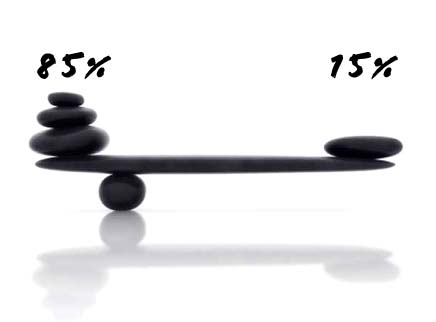
People on an average western diet which is laden with hydrogenated fats and refined carbohydrates have reversed this ratio to 15% and 85% and the evidence of this is all around you.
Let’s look for a moment at carbohydrates; they are the main energy source for the human body. Chemically they are organic molecules in which carbon, hydrogen, and oxygen are bound together. There are two types of carbohydrates, the simple sugars and the complex sugars made of long chains of sugars. Simple sugars are made of units called saccharide units. They are carbohydrates that contain one sugar unit (monosaccharide) or two sugar units (disaccharides). Simple sugars are sweet in taste and are broken down quickly in the body to realize energy in the Krebs cycle of the cells’ mitochondria. Two of the most common saccharides are glucose and fructose. They have same formula (C6H12O6) but different structure. Disaccharides have two sugar units bonded together. Common table sugar is sucrose which consists of a glucose and fructose unit bonded together.
Complex carbohydrates are polymers of simple sugars called complex carbohydrates often referred as polysaccharides or starches. Starch is principally polysaccharides which are used by plants to store glucose. Common sources of starch include rice, beans, wheat, corn, potatoes, and so on. Humans and animals store energy in its own polymer, glycogen. Glycogen is stored in liver and muscles.
Cellulose is a third polymer of the monosaccharide glucose unit which forms a two dimensional structure with a hydrogen bond making the molecule stable. Cellulose, known as plant fiber, cannot be digested by humans. However, the cellulose fiber is essential in the diet because is responsible for the peristaltic movement of the intestines in digestive tract and for keeping it clean and healthy.
The human body cannot tolerate large amounts of refined carbohydrates, the internal vital organs will be damaged by this gross intake of sugar. I would like to demonstrate this using the example of one small republic from the Polynesian archipelago that became addicted to the western diet.
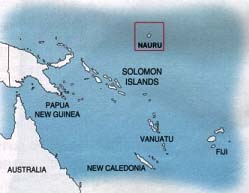
The Micronesian island nation Nauru has been singled out for this presentation. The island is only 8.5 square miles making Nauru the world smallest republic. The traditional life style was based on local agriculture and fishing. The republic was once among the richest in the world due to royalties from phosphate mining. The people were described as strong, muscular and in good health (Huges, 2003) and were capable of canoeing for weeks on the ocean. The population had healthy teeth with no decay or signs of gum disease. One British Doctor after screening hundreds of patients on the archipelago could not find a single cavity; he was in the state of disbelief because in his home country statistics show that 98% of the population have caries and some form gum disease. The people were described as some kind of genetic marvel by European visitors. 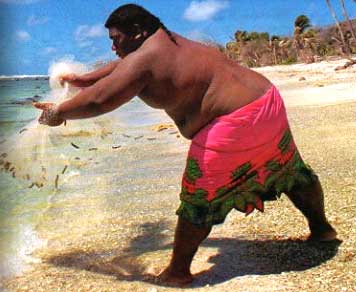
Before and during World War Two, Japanese occupied Nauru. Part of the legacy of this period was adaptation to non-native eating habits. After the war, they increasingly depended on imported food. Their agriculture was abandoned and the population was put exclusively on a western diet. Today Nauruans are “most obese and have the highest blood pressure of all people in the Pacific” (Diamond 2003.p 660). All foods consumed by the Nauruans are imported from Australia, United States and Japan. (Ringrose and Zimmet 1979). Today the prevalence rate of diabetes 78.6% in females 50 to 58 years, 44% in those over the age of 20 and 82.4% in males. ( Zimmet, Alblaster and Thoma 1978 p.145 ). These rates are 20 times that of the Caucasian population and 3 times over urbanized Polynesians. The prevalence increases with age. People after 50 usually have lost their teeth to galloping caries and periodontal disease. This illustrates that nutrition is a major factor affecting our health and our well being. An exclusively western diet will convert in one generation people described as a genetic marvel to a toothless, obese, and sick population.
PERSONAL EXPERIENCES
I would like to share with you a story from my own practice how a change in the environment can destroy your teeth in six months. My patient for many years, whom I considered as an example of perfect dentition with perfect occlusion, healthy gums and beautiful smile converted in six months to a totally disastrous condition of rotten teeth, where all of his teeth were attacked by circumferential caries, the gums were ruby red and would bleed from a blow of air. They were covered with cheesy like substance of material alba with a characteristic smell of decomposition. I was in a state of shock and disbelief. I’d never seen that far advanced condition before. The man was 40 years old and six months before had decided to take off from his business for one year for a sort of a Palm Springs vacation. I had to ask him this question: what did you change, what are you doing now that you had not done before? The answer was very short “I started boozing; I was sipping gin and tonic all day long.” This is a perfect example of a dramatic change of environment. The man was delivering a constant supply of sugar and acid to his mouth, allowing enamel to be dissolved and an extreme overgrowth of sugar fermenting bacteria (S. Mutans) which produced more acid and created this irreversible teeth destruction and gums condition. And all this happened in only six months!
The other patient was a fifty year old male with a full complement of healthy teeth who developed dry mouth syndrome and formed a habit of comforting himself by taking a sip of coca-cola every five minutes and swishing his mouth with it. In seven months, all his teeth were cut out, like beavers cutting trees. The teeth got weakened and one by one were broken off. Coca-cola contains phosphoric acid and lot of sugar.
THE HUMAN MOUTH – HOLISTIC APPROACH
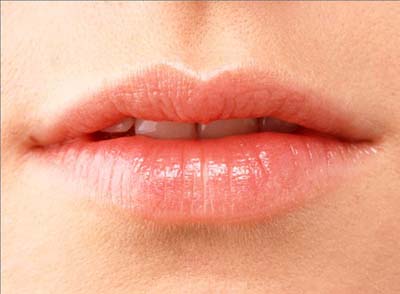 The human mouth is considered to be the major portal of entry for majority of infectious diseases where tonsils and gums will be responsible for practically all chronic human conditions. Gum disease in the early stages of infection is classified as gingivitis meaning limited only to soft tissues, and in more advanced stages involves alveolar bone resorption, it is classified as periodontitis. The condition can be defined as: Periodontal disease is a localized, acquired contagious chronic bacterial infection of the gums and periodontium in a state of dynamic equilibrium between virulence of the pathogen and host defenses. This definition adequately describes only the short lasting early stages of localized infection, limited to mouth periodontitis.
The human mouth is considered to be the major portal of entry for majority of infectious diseases where tonsils and gums will be responsible for practically all chronic human conditions. Gum disease in the early stages of infection is classified as gingivitis meaning limited only to soft tissues, and in more advanced stages involves alveolar bone resorption, it is classified as periodontitis. The condition can be defined as: Periodontal disease is a localized, acquired contagious chronic bacterial infection of the gums and periodontium in a state of dynamic equilibrium between virulence of the pathogen and host defenses. This definition adequately describes only the short lasting early stages of localized infection, limited to mouth periodontitis.
The second stage of periodontitis shall be described as systemic chronic bactereming infection affecting the whole human body. In other words we can say periodontitis is an iceberg whose tip is visible in the human mouth and the rest is hidden inside of the human body. This statement creates a serious problem for our medical community: who is supposed to treat this condition?
This condition requires a thoroughly holistic approach, but our body has been divided into pieces by each specialist claiming his stake. One guy will take a piece of your skin, the other your eye, another your tooth, then another your finger or your foot, and a bunch of others will get inside of your body and divide all of your organs amongst themselves. And the worst part of it all is, they do not communicate among themselves. And all this division is protected by licensing.
A clear example of this type of division and the consequences deriving from it comes from the political arena, when the British divided the Middle East through artificially created borders. They divided people without consideration for their culture, religions, traditions, languages, and put historical enemies within the same borders. The legacy of this is the creation of never-ending territorial disputes and is dominates our political arena still today.
The physical entry of the pathological bacterium to the bloodstream (the condition known as bacteremia) through an inflamed oral portal has lifelong consequences, affecting directly the health and quality of life and in the end becomes a force capable of separating the soul from the body. Like any living thing, bacteria metabolize and produce exotoxins which are capable of producing specific pharmacological actions against the host and are considered the most powerful and lethal poisons known. Some soluble bacterial antigens when in the bloodstream react with specific antibodies of the host to form macromolecular complexes. These give rise to a variety of acute and chronic inflammatory reactions at the sites of deposition leading to array of degenerating diseases, a form of bi-directional interaction in which eventually the host becomes the victim of the disease.
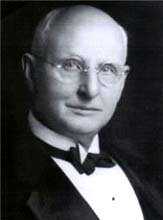
Dr Weston Price
The Journal of Periodontology reported that chronic bacterial infection of the gums causes oral bacteria by-products to enter the bloodstream and trigger the liver to make proteins such as CRP (C- reactive protein) that inflame arteries and promote blood clot formation. The evidence supporting the devastating power of exotoxin can be found in the work of Dr. Weston Price (1870-1948). Dr. Price was a Cleveland dentist. One day a female patient was brought to his practice in a wheelchair. She had been paralyzed for several years. After examination and x-rays it was determined that one of her old root-canalled tooth needed to be extracted. The procedure was performed at the same appointment and the patient was dismissed. A couple of weeks later, Dr. Price received a surprising telephone call from the patient and learned that she was no longer using her wheelchair, and was able to walk on her own again.
That information prompted Dr. Price to investigate the matter; he found the root-canalled tooth and inoculated it under the skin of a rabbit. After two weeks the rabbit was paralyzed. It became obvious that there must be something in that tooth which was causing paralysis. Dr. Price reasoned that the tooth was infected with bacteria and the bacteria was responsible for the paralysis. He sterilized the tooth in an autoclave for 48 hours, making sure that no bacteria was left alive, then inoculated another rabbit, thinking that this time there would be no paralysis. Dr Price in the past had inoculated rabbits with extracts from healthy teeth and they never caused any harm to the animals. To his surprise, the rabbit developed a paralysis like the one before. It became apparent that not the bacteria, but bacteria’s exotoxin was causing the paralysis. You cannot destroyed exotoxins by sterilization.
Please look at the list of chronic systemic diseases presently associated and initiated by the bio-film and planktoning species residing in the human mouth: Osteoporosis, Osteomyelitus, Crohn’s Disease, Pott’s disease (vertebral tuberculosis), Multiple Sclerosis, Rheumatoid Arthritis, Crest Syndrome, Coronary Heart Disease, Myocardial Infractions, Strokes, Acquired Neutropenia, Leukemias, Pancreatic Cancer, Metabolic syndrome, Renal Diseases, Alzheimer’s Disease, Lupus Erythromatosus, Diabetes, High Blood Pressure, Epilepsy, Vision Disorders, Preterm / low birth weight of babys and even Brain Tumors and Cancers. The list is getting bigger every passing year.
TRANSMISSION OF PATHOGENS
The infection is usually transmitted in the early stages of development of the infant from mothers through spoon feeding when mothers are food testing or blowing air to cool down the formula, or is acquired later in teenage years when kissing becomes the reason to be alive. I have been suspecting for a long time that these so-called natural automatic behaviors like kissing, blowing air on food by mothers, babies notoriously stuffing their mouths with soiled toys, actually benefit the bacteria, because in this process there is a massive transfer of bacteria between the objects and individuals. It may even be possible that this behavior is actually initiated by the bacteria itself.
New research by scientists from UMASS medical school published in current Biology shows evidence which for the first time illuminates a biological and ecological path that links all the players involved: from genes to molecules to neural circuits to behaviors to the environment. They were studying how the nervous system generates behaviors and translates sensory information into coordinated motor output. There were studies on three hundred inmates who had committed rage crimes. They concluded that all of them were infected with a strain of streptococcus that was producing a specific neurotoxin affecting the part of the human brain responsible for aggressive reactions, and that the infected individuals did not have any control over it.
Studies in 1970 showed that specific strains of streptococcus mutans are transmitted from mother to a child. This conclusion was confirmed in 1980 by DNA technology. Transmission from child-to-child, and adult-to-adult has also been confirmed. Filament forming catalase positive bacterium, Actynomyces viscosus, when inoculated into non-infected animals induces periodontal lesions and root caries. (Jordan and Keyes 1964). Socransky and coworkers induced periodontal-lesions in gnotobiotic rats by infecting them with human strains of Actynomyces naeslundi (Socransky, Hubersak and Propas 1970). Viscous periodontopatic biofilm transfer from children to rats maintained in germ-free environment induced severe periodontal lesions and roots caries in rats. ( Jordan, Keyes and Bellack 1972). Jordan and Keyes in their experiments of putting disease-free hamsters in the same cage with periodontally infected hamsters were able to prove that the transmission of the disease is possible through casual contact between the animals by simply staying in the same cage and sharing the environment.
All these findings confirm that periodontal disease is a highly contagious far-reaching oral infection with specific strains of bacteria which can be always isolated from infected sites and these bacterial mats (bio-films) differ quantitatively from specimens removed from healthy sites. Significant research has supported this fact. (Loesche,1976, Socranski, 1977, Slots, 1977, and Mellden,1978, Keyes and Rams 1982).
The extraordinary resilience of these infectious microbes, which have a remarkable ability to evolve, adapt, and develop resistance to drugs and chemicals in an unpredictable and dynamic fashion should be considered a bacterial risk factor that should not be given the benefit of the doubt. The chronic state of infection remains symptomless without any discomfort or awareness of the patient, and the condition can last for many years undetected and therefore not treated, allowing for significant destruction of periodontium (peri-odon-tium, the supporting structure of the teeth including the cementum the periodontal ligament, the gums and alveolar bone). The most important of all the pathogens have sufficient time to compromise the host defenses and enter the bloodstream. We now know of the mechanism that when the balance between bacteria virulence and host defenses gets compromised, bacteria, reaching a critical mass and through quorum sensing, will receive awareness of its readiness and will wait for the triggering opportunity, for example the fluctuation in the immune system’s defenses. This will be detected by the bacteria and when the immune system is at its lowest, the attack will be launched. Then the chronic state will turn to an acute state. manifesting all five classic signs of acute infection: tumor, rubor, calor, dolor and funcio lessa.
It needs to be stressed that once exposed and infected with strains of these pathogens, the state of infection will be dwelling in the body all the time. The destructive symptomless chronic infection occasionally will turn to symptomatic acute state. The human mouth has to be considered as an ideal environment for six hundred species of bacteria. The place is warm, moist, and humid with plenty of food, the terrain is multi-formed, solid and aquatic capable of accommodating both forms of bacteria, planktonic and bio-film, in a comfortable setting of an ideal eco-system. The bio-film is occupying the prime real-estate, the beach property, taking advantage of solid and aquatic environment by colonizing the surfaces of the teeth facing, down to the gum sulcus which is full of tissue fluid. As I have mentioned before the humans have same preferences as bacteria.
The bio-film colonies are gently washed with saliva which is a rich source of minerals and is laden with dissolved sugars. Saliva also is equipped with its own enzyme “amylase” which cuts long-chain sugars like starches to short-chained sugars, sort of preparing food on the spot for bacterial consumption. The planktonic form of the bacteria have an aquatic environment of eight liters of saliva flowing through the human mouth in 24 hours and gingival cervicular fluid (GCF) the blood serum transudate.
We all know that our blood carries a significant amount of glucose in the serum and GCF being a serum transudate will have only 1/10 less of glucose in cervicular fluid than in the whole blood. This explains why people suffering from diabetes will be also suffering from severe periodontitus, simply because they have more glucose in their GCF and saliva, therefore more bacteria will grow and faster overwhelm the environment, causing destruction to teeth and periodontium. (The time factor for this to occur, referring to two examples from my practice, is 6 to 7 months). This is the same reason that the people from Nauru lost their teeth due to periodontitus, and caries.

SKY:
Symbol of masculine domination; place of Gods.
